HI5019 Strategic Information System: A DELL Case Study Review
VerifiedAdded on 2023/06/12
|13
|3188
|299
Literature Review
AI Summary
This literature review examines Dell's strategic information system, starting with the company's founding vision and its growth into a global IT solutions provider. It delves into Dell's current processes, highlighting the role of IT strategy and governance, and identifies gaps and problems within the existing systems, particularly those arising from acquisitions and the complexities of managing multiple systems. The review emphasizes the importance of establishing a robust business architecture, aligning IT initiatives with business goals, and streamlining IT infrastructure. It discusses the need for rationalization, consolidation, and standardization to improve efficiency and reduce costs. The review also explores the elimination process of redundant systems, the reorganization of the company around key functions, and the solutions to identified problems, including prioritizing IT investments and enforcing technology reference models. The role of architects in understanding departmental needs and maintaining cross-domain perspectives is highlighted, ultimately emphasizing that business architects are not merely process analysts but strategic visionaries. This document is a student contribution and is available, along with other resources, on Desklib.
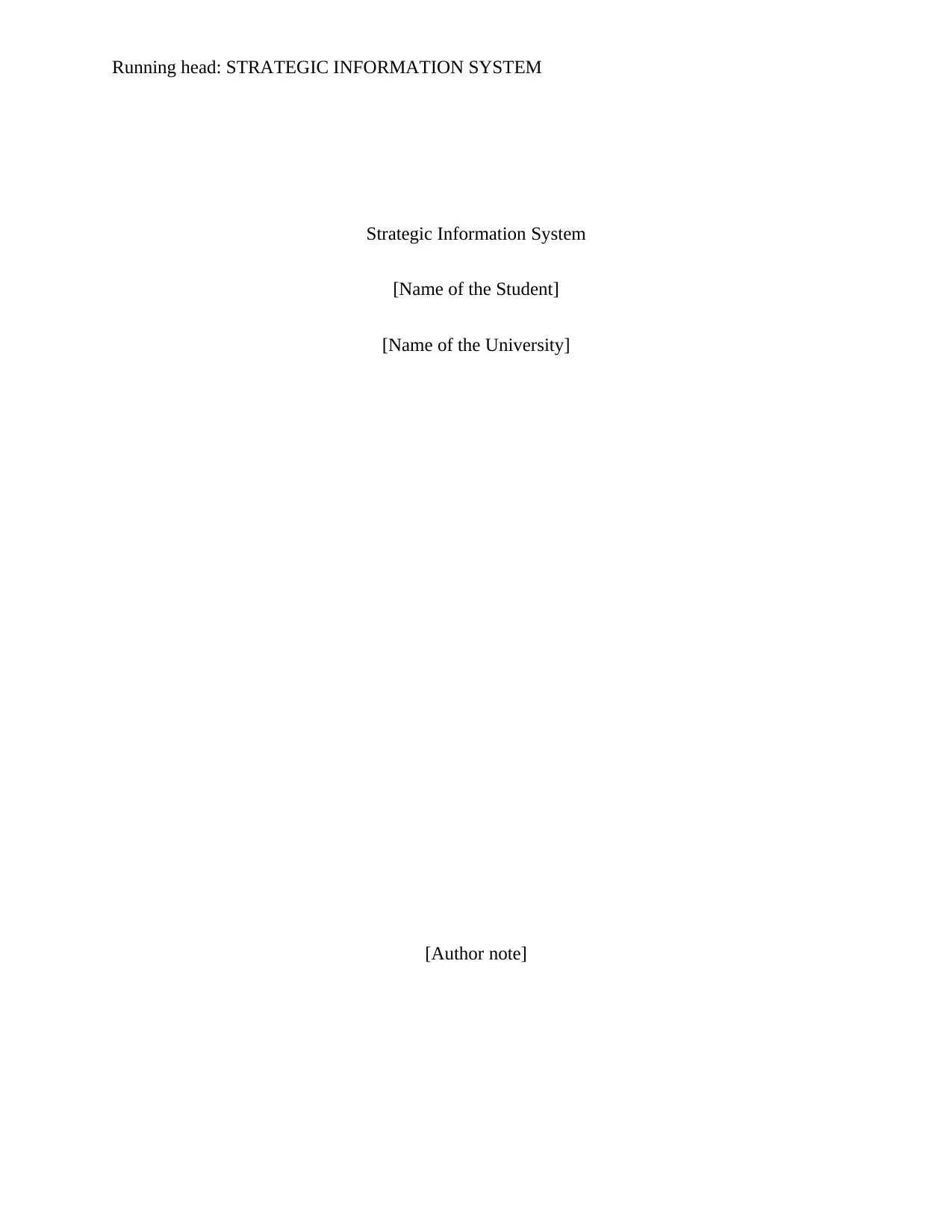
Running head: STRATEGIC INFORMATION SYSTEM
Strategic Information System
[Name of the Student]
[Name of the University]
[Author note]
Strategic Information System
[Name of the Student]
[Name of the University]
[Author note]
Paraphrase This Document
Need a fresh take? Get an instant paraphrase of this document with our AI Paraphraser
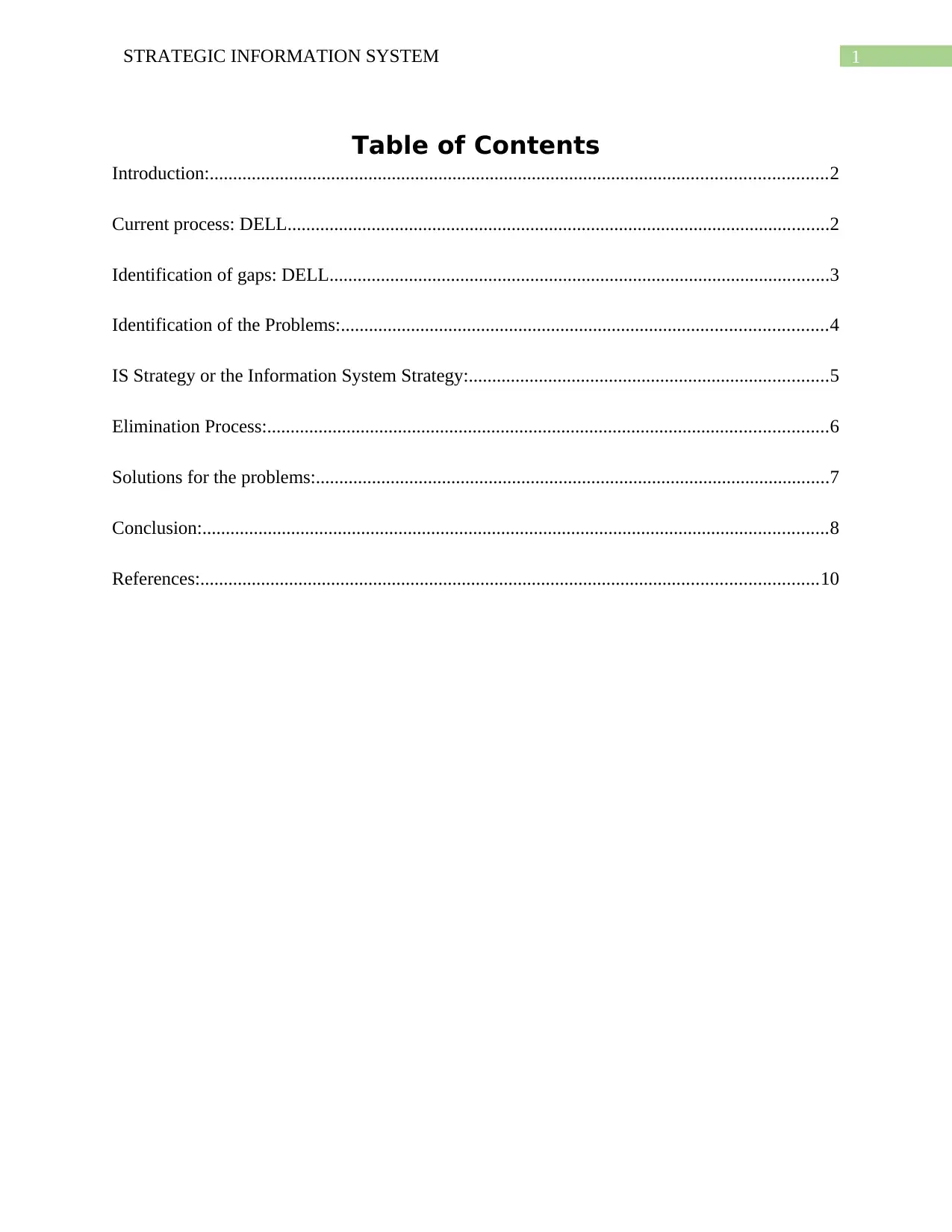
1STRATEGIC INFORMATION SYSTEM
Table of Contents
Introduction:....................................................................................................................................2
Current process: DELL....................................................................................................................2
Identification of gaps: DELL...........................................................................................................3
Identification of the Problems:........................................................................................................4
IS Strategy or the Information System Strategy:.............................................................................5
Elimination Process:........................................................................................................................6
Solutions for the problems:..............................................................................................................7
Conclusion:......................................................................................................................................8
References:....................................................................................................................................10
Table of Contents
Introduction:....................................................................................................................................2
Current process: DELL....................................................................................................................2
Identification of gaps: DELL...........................................................................................................3
Identification of the Problems:........................................................................................................4
IS Strategy or the Information System Strategy:.............................................................................5
Elimination Process:........................................................................................................................6
Solutions for the problems:..............................................................................................................7
Conclusion:......................................................................................................................................8
References:....................................................................................................................................10
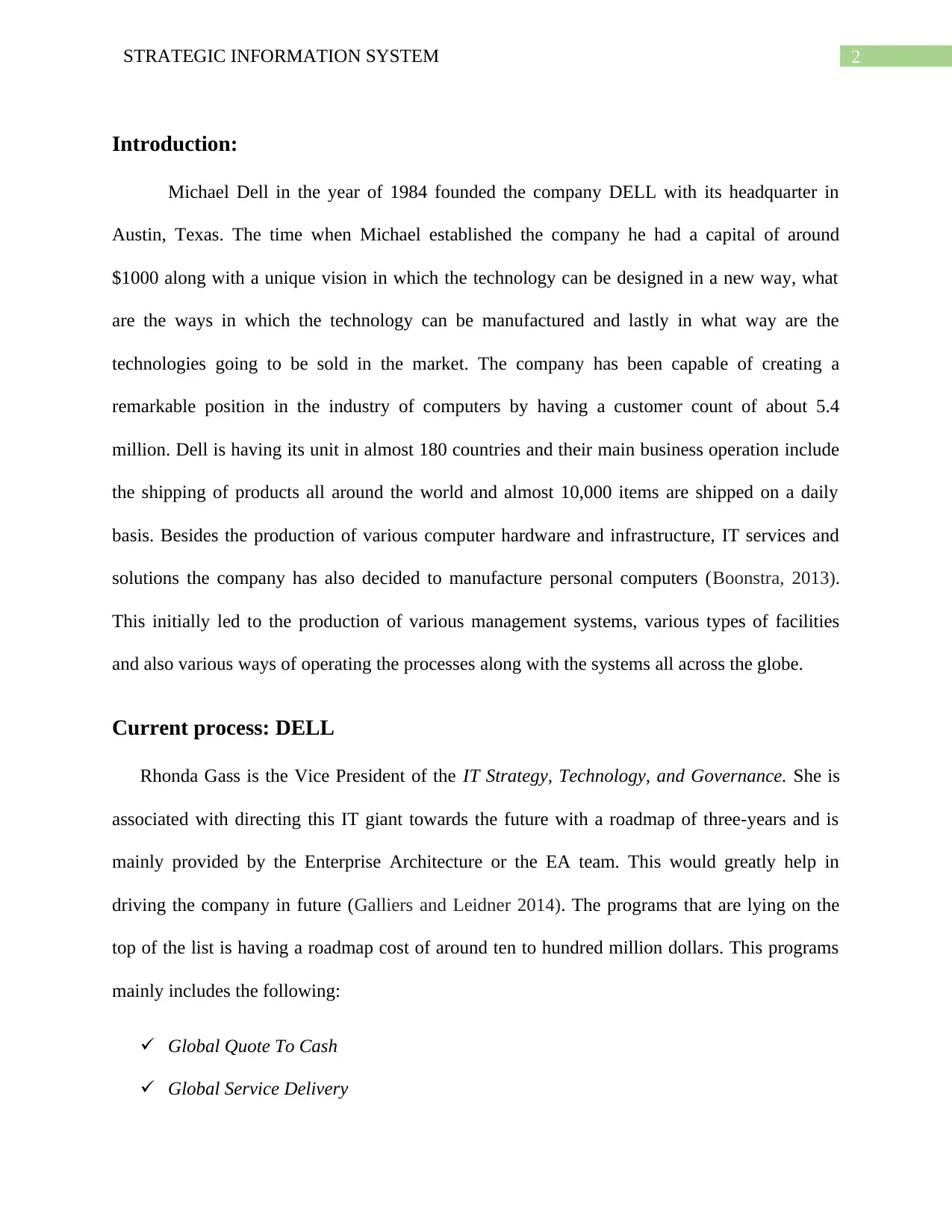
2STRATEGIC INFORMATION SYSTEM
Introduction:
Michael Dell in the year of 1984 founded the company DELL with its headquarter in
Austin, Texas. The time when Michael established the company he had a capital of around
$1000 along with a unique vision in which the technology can be designed in a new way, what
are the ways in which the technology can be manufactured and lastly in what way are the
technologies going to be sold in the market. The company has been capable of creating a
remarkable position in the industry of computers by having a customer count of about 5.4
million. Dell is having its unit in almost 180 countries and their main business operation include
the shipping of products all around the world and almost 10,000 items are shipped on a daily
basis. Besides the production of various computer hardware and infrastructure, IT services and
solutions the company has also decided to manufacture personal computers (Boonstra, 2013).
This initially led to the production of various management systems, various types of facilities
and also various ways of operating the processes along with the systems all across the globe.
Current process: DELL
Rhonda Gass is the Vice President of the IT Strategy, Technology, and Governance. She is
associated with directing this IT giant towards the future with a roadmap of three-years and is
mainly provided by the Enterprise Architecture or the EA team. This would greatly help in
driving the company in future (Galliers and Leidner 2014). The programs that are lying on the
top of the list is having a roadmap cost of around ten to hundred million dollars. This programs
mainly includes the following:
Global Quote To Cash
Global Service Delivery
Introduction:
Michael Dell in the year of 1984 founded the company DELL with its headquarter in
Austin, Texas. The time when Michael established the company he had a capital of around
$1000 along with a unique vision in which the technology can be designed in a new way, what
are the ways in which the technology can be manufactured and lastly in what way are the
technologies going to be sold in the market. The company has been capable of creating a
remarkable position in the industry of computers by having a customer count of about 5.4
million. Dell is having its unit in almost 180 countries and their main business operation include
the shipping of products all around the world and almost 10,000 items are shipped on a daily
basis. Besides the production of various computer hardware and infrastructure, IT services and
solutions the company has also decided to manufacture personal computers (Boonstra, 2013).
This initially led to the production of various management systems, various types of facilities
and also various ways of operating the processes along with the systems all across the globe.
Current process: DELL
Rhonda Gass is the Vice President of the IT Strategy, Technology, and Governance. She is
associated with directing this IT giant towards the future with a roadmap of three-years and is
mainly provided by the Enterprise Architecture or the EA team. This would greatly help in
driving the company in future (Galliers and Leidner 2014). The programs that are lying on the
top of the list is having a roadmap cost of around ten to hundred million dollars. This programs
mainly includes the following:
Global Quote To Cash
Global Service Delivery
⊘ This is a preview!⊘
Do you want full access?
Subscribe today to unlock all pages.

Trusted by 1+ million students worldwide
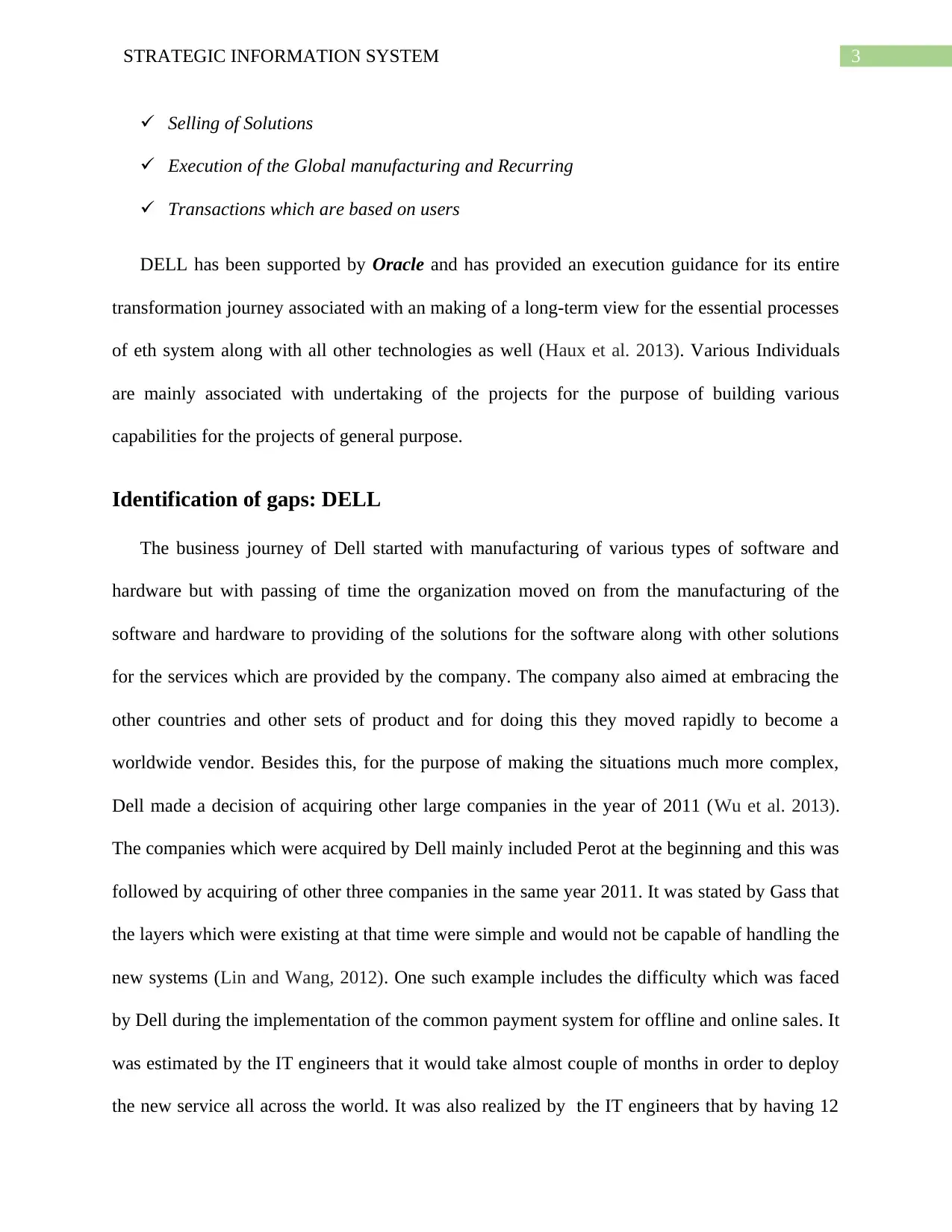
3STRATEGIC INFORMATION SYSTEM
Selling of Solutions
Execution of the Global manufacturing and Recurring
Transactions which are based on users
DELL has been supported by Oracle and has provided an execution guidance for its entire
transformation journey associated with an making of a long-term view for the essential processes
of eth system along with all other technologies as well (Haux et al. 2013). Various Individuals
are mainly associated with undertaking of the projects for the purpose of building various
capabilities for the projects of general purpose.
Identification of gaps: DELL
The business journey of Dell started with manufacturing of various types of software and
hardware but with passing of time the organization moved on from the manufacturing of the
software and hardware to providing of the solutions for the software along with other solutions
for the services which are provided by the company. The company also aimed at embracing the
other countries and other sets of product and for doing this they moved rapidly to become a
worldwide vendor. Besides this, for the purpose of making the situations much more complex,
Dell made a decision of acquiring other large companies in the year of 2011 (Wu et al. 2013).
The companies which were acquired by Dell mainly included Perot at the beginning and this was
followed by acquiring of other three companies in the same year 2011. It was stated by Gass that
the layers which were existing at that time were simple and would not be capable of handling the
new systems (Lin and Wang, 2012). One such example includes the difficulty which was faced
by Dell during the implementation of the common payment system for offline and online sales. It
was estimated by the IT engineers that it would take almost couple of months in order to deploy
the new service all across the world. It was also realized by the IT engineers that by having 12
Selling of Solutions
Execution of the Global manufacturing and Recurring
Transactions which are based on users
DELL has been supported by Oracle and has provided an execution guidance for its entire
transformation journey associated with an making of a long-term view for the essential processes
of eth system along with all other technologies as well (Haux et al. 2013). Various Individuals
are mainly associated with undertaking of the projects for the purpose of building various
capabilities for the projects of general purpose.
Identification of gaps: DELL
The business journey of Dell started with manufacturing of various types of software and
hardware but with passing of time the organization moved on from the manufacturing of the
software and hardware to providing of the solutions for the software along with other solutions
for the services which are provided by the company. The company also aimed at embracing the
other countries and other sets of product and for doing this they moved rapidly to become a
worldwide vendor. Besides this, for the purpose of making the situations much more complex,
Dell made a decision of acquiring other large companies in the year of 2011 (Wu et al. 2013).
The companies which were acquired by Dell mainly included Perot at the beginning and this was
followed by acquiring of other three companies in the same year 2011. It was stated by Gass that
the layers which were existing at that time were simple and would not be capable of handling the
new systems (Lin and Wang, 2012). One such example includes the difficulty which was faced
by Dell during the implementation of the common payment system for offline and online sales. It
was estimated by the IT engineers that it would take almost couple of months in order to deploy
the new service all across the world. It was also realized by the IT engineers that by having 12
Paraphrase This Document
Need a fresh take? Get an instant paraphrase of this document with our AI Paraphraser
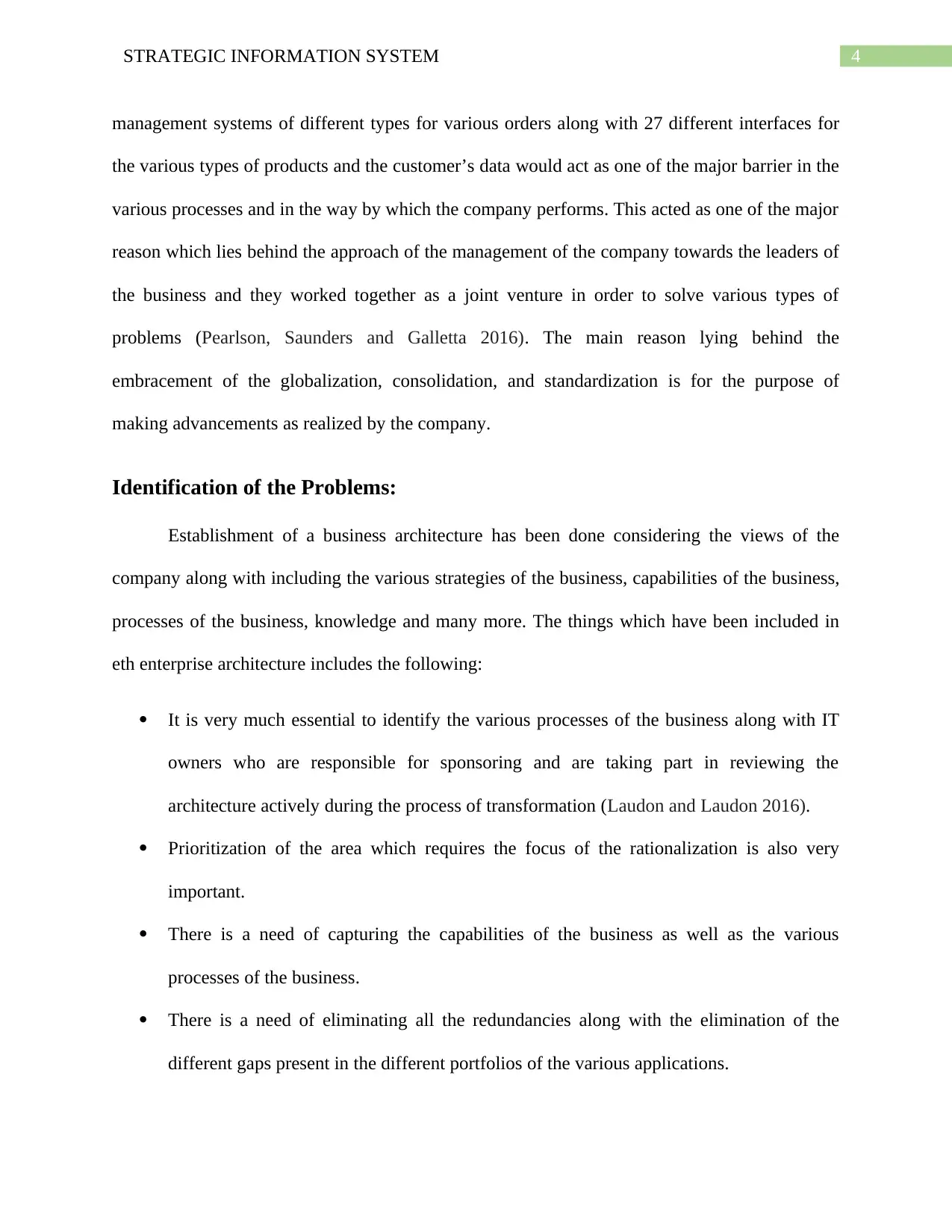
4STRATEGIC INFORMATION SYSTEM
management systems of different types for various orders along with 27 different interfaces for
the various types of products and the customer’s data would act as one of the major barrier in the
various processes and in the way by which the company performs. This acted as one of the major
reason which lies behind the approach of the management of the company towards the leaders of
the business and they worked together as a joint venture in order to solve various types of
problems (Pearlson, Saunders and Galletta 2016). The main reason lying behind the
embracement of the globalization, consolidation, and standardization is for the purpose of
making advancements as realized by the company.
Identification of the Problems:
Establishment of a business architecture has been done considering the views of the
company along with including the various strategies of the business, capabilities of the business,
processes of the business, knowledge and many more. The things which have been included in
eth enterprise architecture includes the following:
It is very much essential to identify the various processes of the business along with IT
owners who are responsible for sponsoring and are taking part in reviewing the
architecture actively during the process of transformation (Laudon and Laudon 2016).
Prioritization of the area which requires the focus of the rationalization is also very
important.
There is a need of capturing the capabilities of the business as well as the various
processes of the business.
There is a need of eliminating all the redundancies along with the elimination of the
different gaps present in the different portfolios of the various applications.
management systems of different types for various orders along with 27 different interfaces for
the various types of products and the customer’s data would act as one of the major barrier in the
various processes and in the way by which the company performs. This acted as one of the major
reason which lies behind the approach of the management of the company towards the leaders of
the business and they worked together as a joint venture in order to solve various types of
problems (Pearlson, Saunders and Galletta 2016). The main reason lying behind the
embracement of the globalization, consolidation, and standardization is for the purpose of
making advancements as realized by the company.
Identification of the Problems:
Establishment of a business architecture has been done considering the views of the
company along with including the various strategies of the business, capabilities of the business,
processes of the business, knowledge and many more. The things which have been included in
eth enterprise architecture includes the following:
It is very much essential to identify the various processes of the business along with IT
owners who are responsible for sponsoring and are taking part in reviewing the
architecture actively during the process of transformation (Laudon and Laudon 2016).
Prioritization of the area which requires the focus of the rationalization is also very
important.
There is a need of capturing the capabilities of the business as well as the various
processes of the business.
There is a need of eliminating all the redundancies along with the elimination of the
different gaps present in the different portfolios of the various applications.
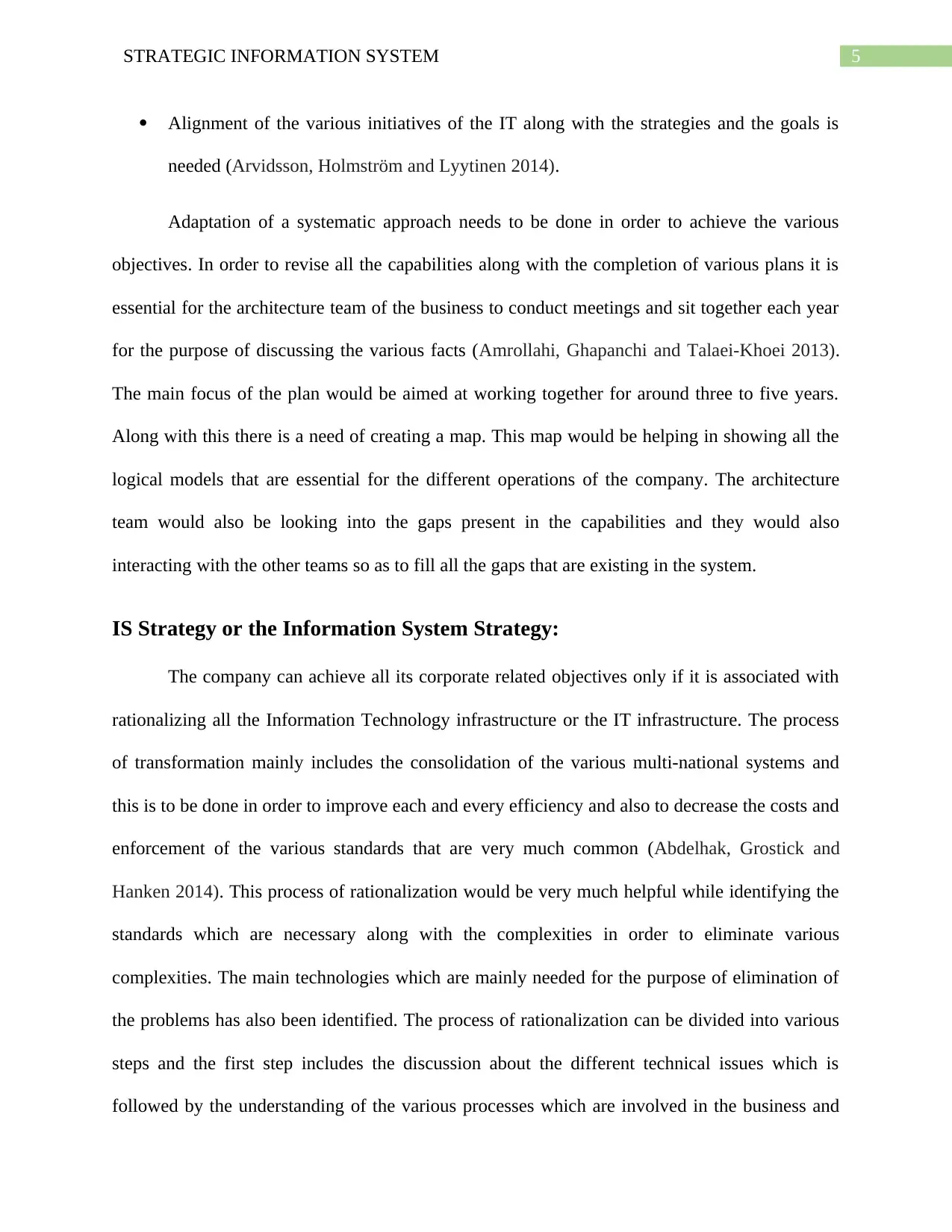
5STRATEGIC INFORMATION SYSTEM
Alignment of the various initiatives of the IT along with the strategies and the goals is
needed (Arvidsson, Holmström and Lyytinen 2014).
Adaptation of a systematic approach needs to be done in order to achieve the various
objectives. In order to revise all the capabilities along with the completion of various plans it is
essential for the architecture team of the business to conduct meetings and sit together each year
for the purpose of discussing the various facts (Amrollahi, Ghapanchi and Talaei-Khoei 2013).
The main focus of the plan would be aimed at working together for around three to five years.
Along with this there is a need of creating a map. This map would be helping in showing all the
logical models that are essential for the different operations of the company. The architecture
team would also be looking into the gaps present in the capabilities and they would also
interacting with the other teams so as to fill all the gaps that are existing in the system.
IS Strategy or the Information System Strategy:
The company can achieve all its corporate related objectives only if it is associated with
rationalizing all the Information Technology infrastructure or the IT infrastructure. The process
of transformation mainly includes the consolidation of the various multi-national systems and
this is to be done in order to improve each and every efficiency and also to decrease the costs and
enforcement of the various standards that are very much common (Abdelhak, Grostick and
Hanken 2014). This process of rationalization would be very much helpful while identifying the
standards which are necessary along with the complexities in order to eliminate various
complexities. The main technologies which are mainly needed for the purpose of elimination of
the problems has also been identified. The process of rationalization can be divided into various
steps and the first step includes the discussion about the different technical issues which is
followed by the understanding of the various processes which are involved in the business and
Alignment of the various initiatives of the IT along with the strategies and the goals is
needed (Arvidsson, Holmström and Lyytinen 2014).
Adaptation of a systematic approach needs to be done in order to achieve the various
objectives. In order to revise all the capabilities along with the completion of various plans it is
essential for the architecture team of the business to conduct meetings and sit together each year
for the purpose of discussing the various facts (Amrollahi, Ghapanchi and Talaei-Khoei 2013).
The main focus of the plan would be aimed at working together for around three to five years.
Along with this there is a need of creating a map. This map would be helping in showing all the
logical models that are essential for the different operations of the company. The architecture
team would also be looking into the gaps present in the capabilities and they would also
interacting with the other teams so as to fill all the gaps that are existing in the system.
IS Strategy or the Information System Strategy:
The company can achieve all its corporate related objectives only if it is associated with
rationalizing all the Information Technology infrastructure or the IT infrastructure. The process
of transformation mainly includes the consolidation of the various multi-national systems and
this is to be done in order to improve each and every efficiency and also to decrease the costs and
enforcement of the various standards that are very much common (Abdelhak, Grostick and
Hanken 2014). This process of rationalization would be very much helpful while identifying the
standards which are necessary along with the complexities in order to eliminate various
complexities. The main technologies which are mainly needed for the purpose of elimination of
the problems has also been identified. The process of rationalization can be divided into various
steps and the first step includes the discussion about the different technical issues which is
followed by the understanding of the various processes which are involved in the business and
⊘ This is a preview!⊘
Do you want full access?
Subscribe today to unlock all pages.

Trusted by 1+ million students worldwide
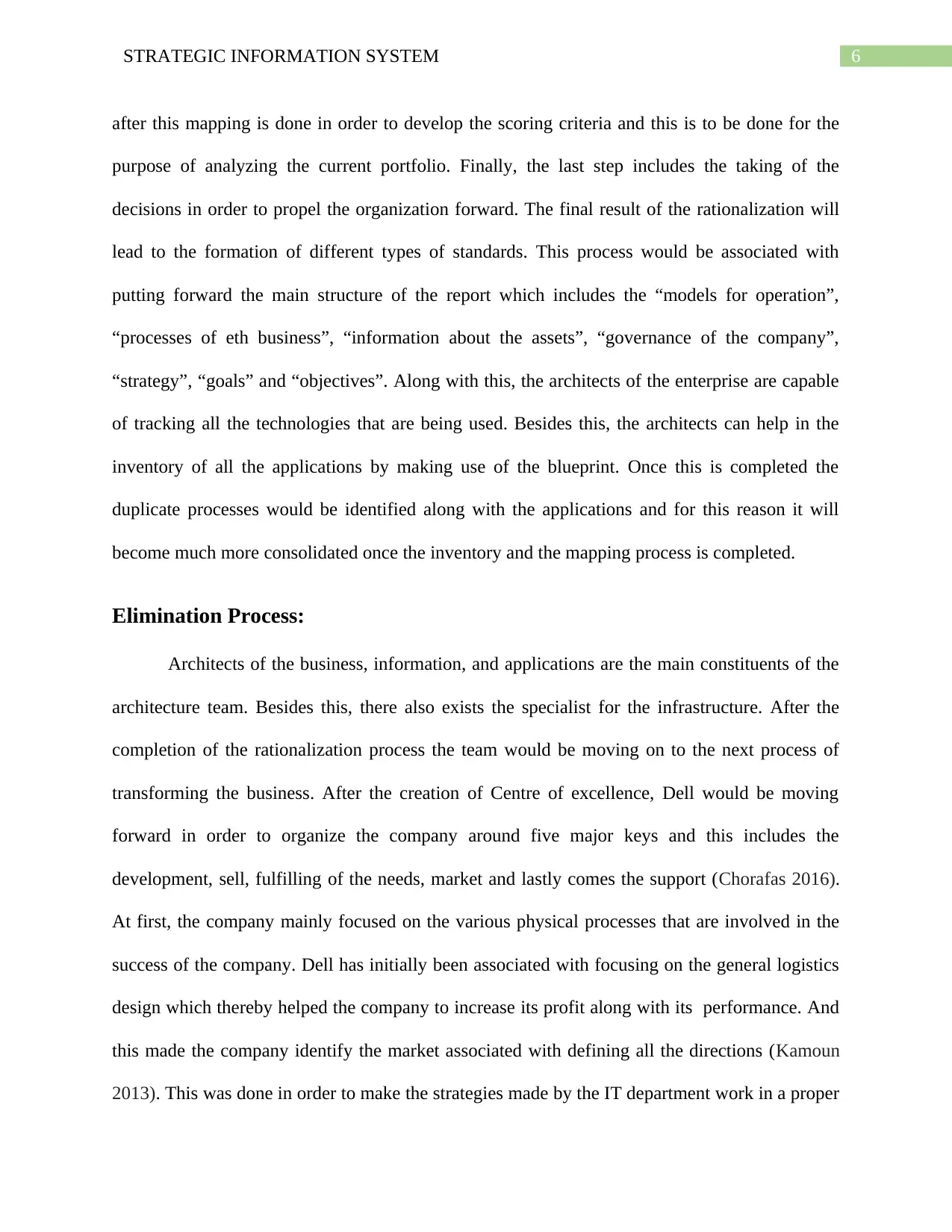
6STRATEGIC INFORMATION SYSTEM
after this mapping is done in order to develop the scoring criteria and this is to be done for the
purpose of analyzing the current portfolio. Finally, the last step includes the taking of the
decisions in order to propel the organization forward. The final result of the rationalization will
lead to the formation of different types of standards. This process would be associated with
putting forward the main structure of the report which includes the “models for operation”,
“processes of eth business”, “information about the assets”, “governance of the company”,
“strategy”, “goals” and “objectives”. Along with this, the architects of the enterprise are capable
of tracking all the technologies that are being used. Besides this, the architects can help in the
inventory of all the applications by making use of the blueprint. Once this is completed the
duplicate processes would be identified along with the applications and for this reason it will
become much more consolidated once the inventory and the mapping process is completed.
Elimination Process:
Architects of the business, information, and applications are the main constituents of the
architecture team. Besides this, there also exists the specialist for the infrastructure. After the
completion of the rationalization process the team would be moving on to the next process of
transforming the business. After the creation of Centre of excellence, Dell would be moving
forward in order to organize the company around five major keys and this includes the
development, sell, fulfilling of the needs, market and lastly comes the support (Chorafas 2016).
At first, the company mainly focused on the various physical processes that are involved in the
success of the company. Dell has initially been associated with focusing on the general logistics
design which thereby helped the company to increase its profit along with its performance. And
this made the company identify the market associated with defining all the directions (Kamoun
2013). This was done in order to make the strategies made by the IT department work in a proper
after this mapping is done in order to develop the scoring criteria and this is to be done for the
purpose of analyzing the current portfolio. Finally, the last step includes the taking of the
decisions in order to propel the organization forward. The final result of the rationalization will
lead to the formation of different types of standards. This process would be associated with
putting forward the main structure of the report which includes the “models for operation”,
“processes of eth business”, “information about the assets”, “governance of the company”,
“strategy”, “goals” and “objectives”. Along with this, the architects of the enterprise are capable
of tracking all the technologies that are being used. Besides this, the architects can help in the
inventory of all the applications by making use of the blueprint. Once this is completed the
duplicate processes would be identified along with the applications and for this reason it will
become much more consolidated once the inventory and the mapping process is completed.
Elimination Process:
Architects of the business, information, and applications are the main constituents of the
architecture team. Besides this, there also exists the specialist for the infrastructure. After the
completion of the rationalization process the team would be moving on to the next process of
transforming the business. After the creation of Centre of excellence, Dell would be moving
forward in order to organize the company around five major keys and this includes the
development, sell, fulfilling of the needs, market and lastly comes the support (Chorafas 2016).
At first, the company mainly focused on the various physical processes that are involved in the
success of the company. Dell has initially been associated with focusing on the general logistics
design which thereby helped the company to increase its profit along with its performance. And
this made the company identify the market associated with defining all the directions (Kamoun
2013). This was done in order to make the strategies made by the IT department work in a proper
Paraphrase This Document
Need a fresh take? Get an instant paraphrase of this document with our AI Paraphraser
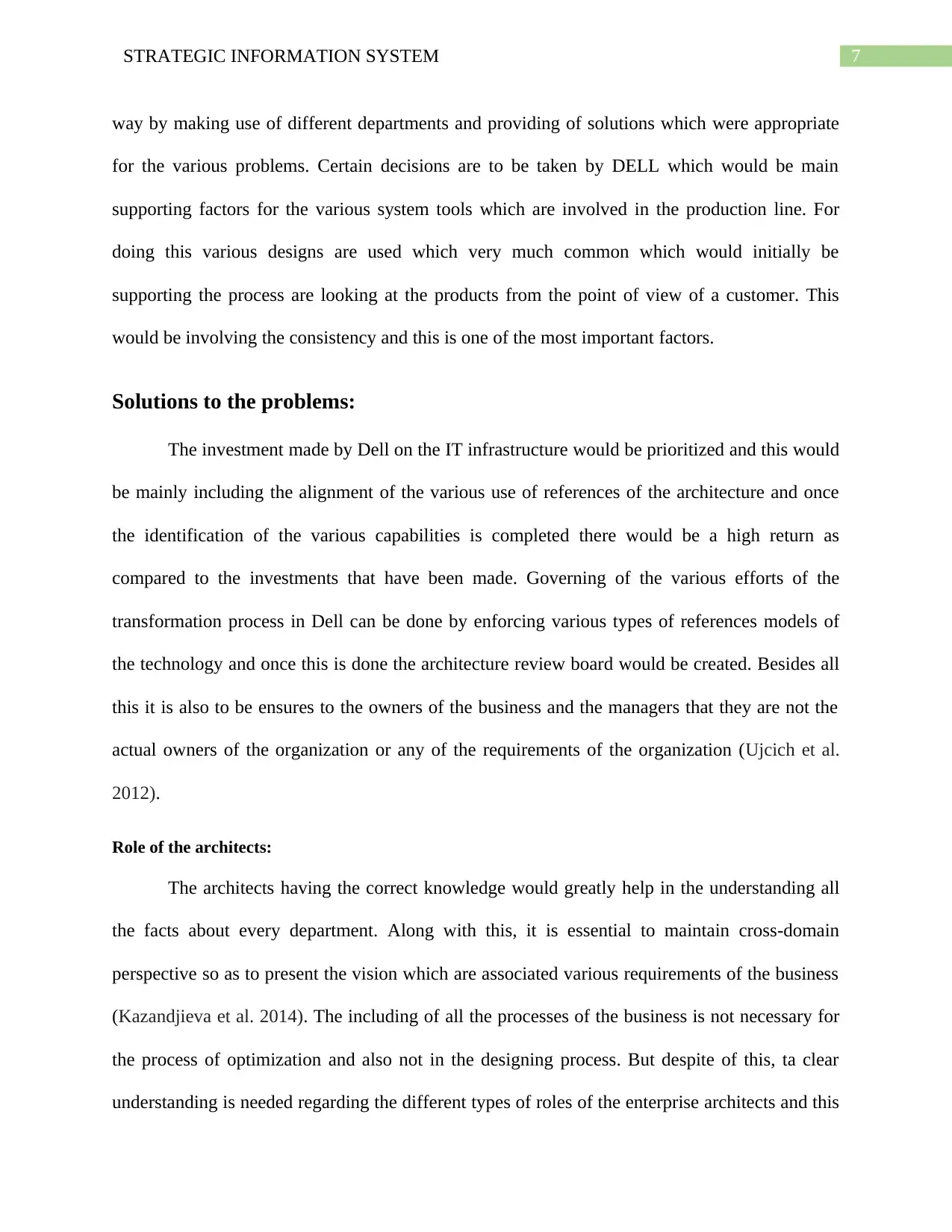
7STRATEGIC INFORMATION SYSTEM
way by making use of different departments and providing of solutions which were appropriate
for the various problems. Certain decisions are to be taken by DELL which would be main
supporting factors for the various system tools which are involved in the production line. For
doing this various designs are used which very much common which would initially be
supporting the process are looking at the products from the point of view of a customer. This
would be involving the consistency and this is one of the most important factors.
Solutions to the problems:
The investment made by Dell on the IT infrastructure would be prioritized and this would
be mainly including the alignment of the various use of references of the architecture and once
the identification of the various capabilities is completed there would be a high return as
compared to the investments that have been made. Governing of the various efforts of the
transformation process in Dell can be done by enforcing various types of references models of
the technology and once this is done the architecture review board would be created. Besides all
this it is also to be ensures to the owners of the business and the managers that they are not the
actual owners of the organization or any of the requirements of the organization (Ujcich et al.
2012).
Role of the architects:
The architects having the correct knowledge would greatly help in the understanding all
the facts about every department. Along with this, it is essential to maintain cross-domain
perspective so as to present the vision which are associated various requirements of the business
(Kazandjieva et al. 2014). The including of all the processes of the business is not necessary for
the process of optimization and also not in the designing process. But despite of this, ta clear
understanding is needed regarding the different types of roles of the enterprise architects and this
way by making use of different departments and providing of solutions which were appropriate
for the various problems. Certain decisions are to be taken by DELL which would be main
supporting factors for the various system tools which are involved in the production line. For
doing this various designs are used which very much common which would initially be
supporting the process are looking at the products from the point of view of a customer. This
would be involving the consistency and this is one of the most important factors.
Solutions to the problems:
The investment made by Dell on the IT infrastructure would be prioritized and this would
be mainly including the alignment of the various use of references of the architecture and once
the identification of the various capabilities is completed there would be a high return as
compared to the investments that have been made. Governing of the various efforts of the
transformation process in Dell can be done by enforcing various types of references models of
the technology and once this is done the architecture review board would be created. Besides all
this it is also to be ensures to the owners of the business and the managers that they are not the
actual owners of the organization or any of the requirements of the organization (Ujcich et al.
2012).
Role of the architects:
The architects having the correct knowledge would greatly help in the understanding all
the facts about every department. Along with this, it is essential to maintain cross-domain
perspective so as to present the vision which are associated various requirements of the business
(Kazandjieva et al. 2014). The including of all the processes of the business is not necessary for
the process of optimization and also not in the designing process. But despite of this, ta clear
understanding is needed regarding the different types of roles of the enterprise architects and this
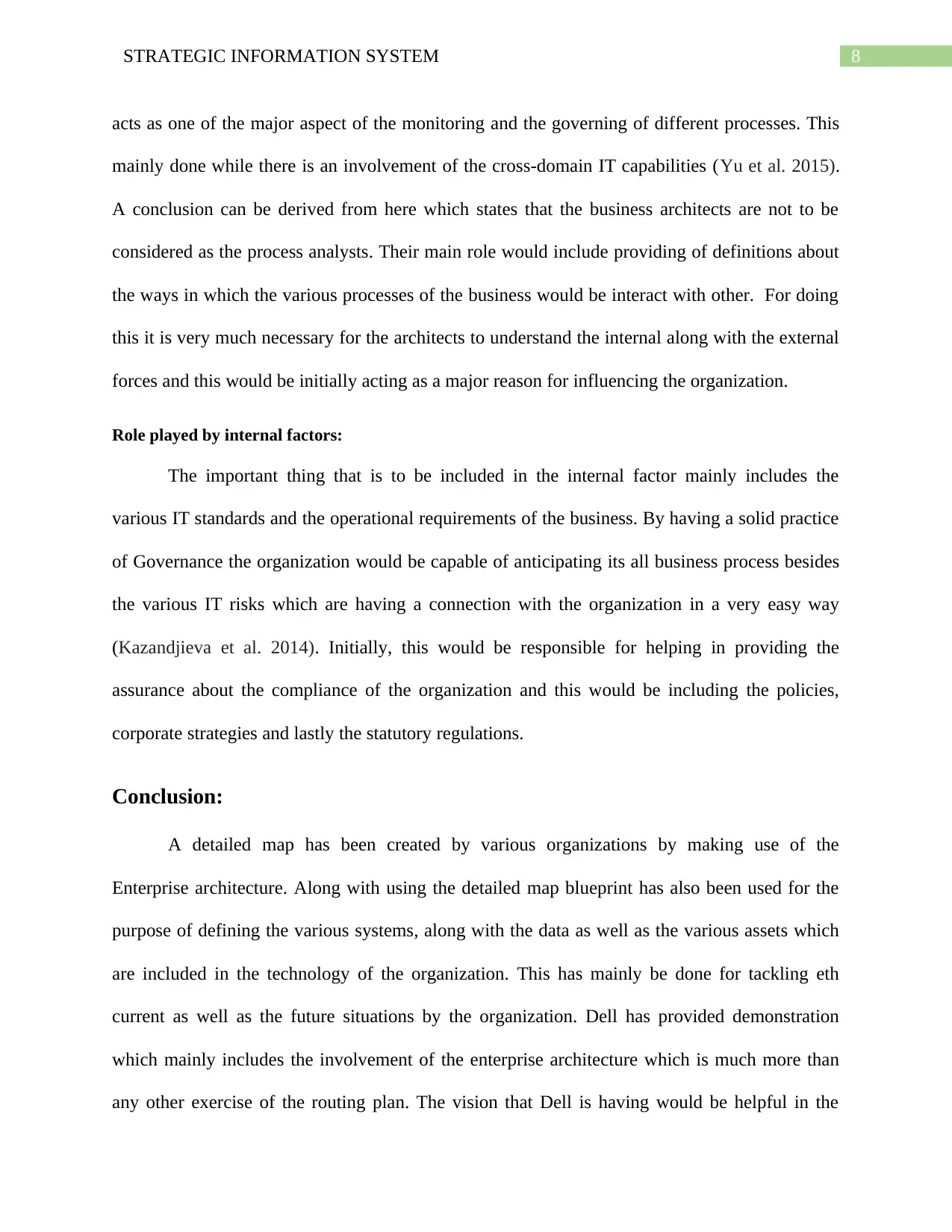
8STRATEGIC INFORMATION SYSTEM
acts as one of the major aspect of the monitoring and the governing of different processes. This
mainly done while there is an involvement of the cross-domain IT capabilities (Yu et al. 2015).
A conclusion can be derived from here which states that the business architects are not to be
considered as the process analysts. Their main role would include providing of definitions about
the ways in which the various processes of the business would be interact with other. For doing
this it is very much necessary for the architects to understand the internal along with the external
forces and this would be initially acting as a major reason for influencing the organization.
Role played by internal factors:
The important thing that is to be included in the internal factor mainly includes the
various IT standards and the operational requirements of the business. By having a solid practice
of Governance the organization would be capable of anticipating its all business process besides
the various IT risks which are having a connection with the organization in a very easy way
(Kazandjieva et al. 2014). Initially, this would be responsible for helping in providing the
assurance about the compliance of the organization and this would be including the policies,
corporate strategies and lastly the statutory regulations.
Conclusion:
A detailed map has been created by various organizations by making use of the
Enterprise architecture. Along with using the detailed map blueprint has also been used for the
purpose of defining the various systems, along with the data as well as the various assets which
are included in the technology of the organization. This has mainly be done for tackling eth
current as well as the future situations by the organization. Dell has provided demonstration
which mainly includes the involvement of the enterprise architecture which is much more than
any other exercise of the routing plan. The vision that Dell is having would be helpful in the
acts as one of the major aspect of the monitoring and the governing of different processes. This
mainly done while there is an involvement of the cross-domain IT capabilities (Yu et al. 2015).
A conclusion can be derived from here which states that the business architects are not to be
considered as the process analysts. Their main role would include providing of definitions about
the ways in which the various processes of the business would be interact with other. For doing
this it is very much necessary for the architects to understand the internal along with the external
forces and this would be initially acting as a major reason for influencing the organization.
Role played by internal factors:
The important thing that is to be included in the internal factor mainly includes the
various IT standards and the operational requirements of the business. By having a solid practice
of Governance the organization would be capable of anticipating its all business process besides
the various IT risks which are having a connection with the organization in a very easy way
(Kazandjieva et al. 2014). Initially, this would be responsible for helping in providing the
assurance about the compliance of the organization and this would be including the policies,
corporate strategies and lastly the statutory regulations.
Conclusion:
A detailed map has been created by various organizations by making use of the
Enterprise architecture. Along with using the detailed map blueprint has also been used for the
purpose of defining the various systems, along with the data as well as the various assets which
are included in the technology of the organization. This has mainly be done for tackling eth
current as well as the future situations by the organization. Dell has provided demonstration
which mainly includes the involvement of the enterprise architecture which is much more than
any other exercise of the routing plan. The vision that Dell is having would be helpful in the
⊘ This is a preview!⊘
Do you want full access?
Subscribe today to unlock all pages.

Trusted by 1+ million students worldwide
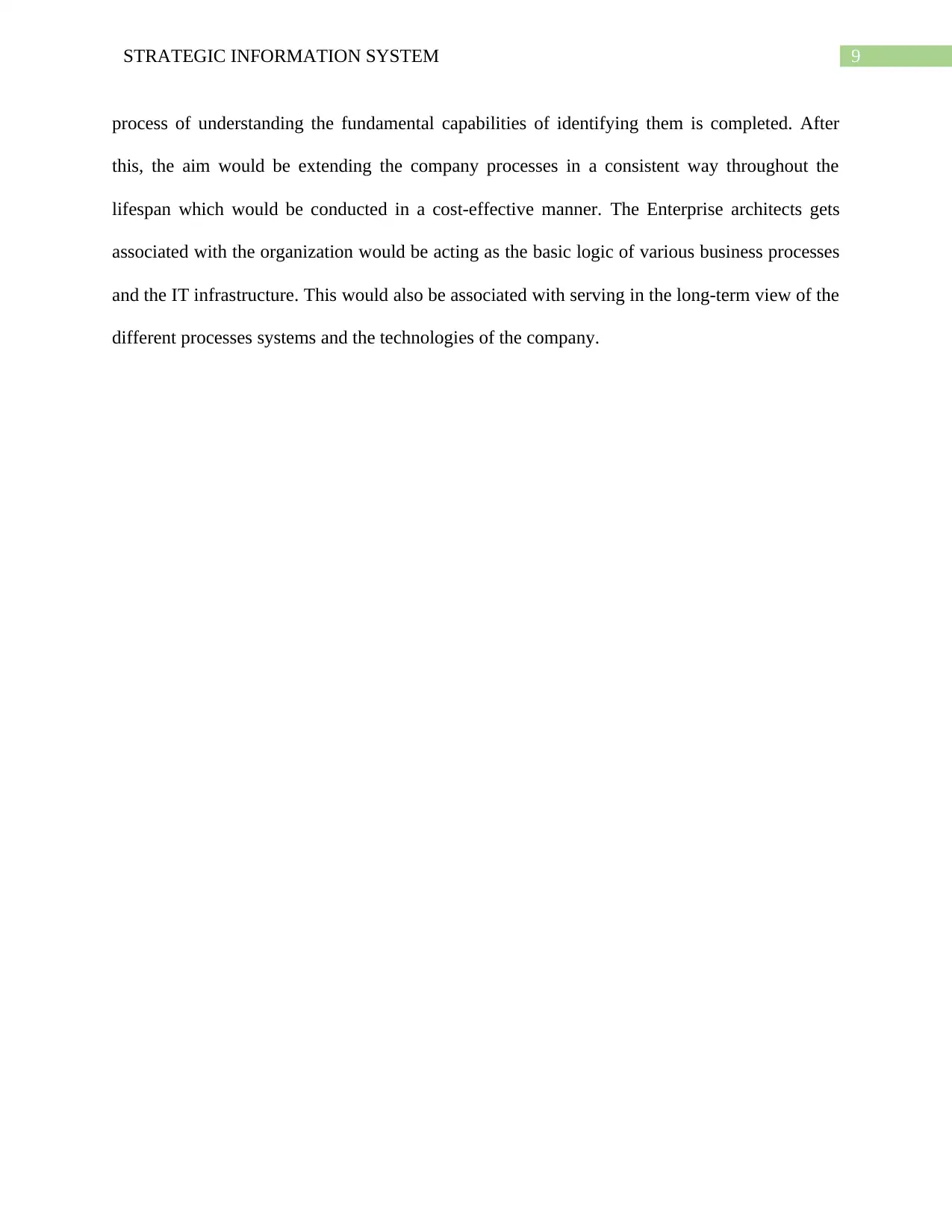
9STRATEGIC INFORMATION SYSTEM
process of understanding the fundamental capabilities of identifying them is completed. After
this, the aim would be extending the company processes in a consistent way throughout the
lifespan which would be conducted in a cost-effective manner. The Enterprise architects gets
associated with the organization would be acting as the basic logic of various business processes
and the IT infrastructure. This would also be associated with serving in the long-term view of the
different processes systems and the technologies of the company.
process of understanding the fundamental capabilities of identifying them is completed. After
this, the aim would be extending the company processes in a consistent way throughout the
lifespan which would be conducted in a cost-effective manner. The Enterprise architects gets
associated with the organization would be acting as the basic logic of various business processes
and the IT infrastructure. This would also be associated with serving in the long-term view of the
different processes systems and the technologies of the company.
Paraphrase This Document
Need a fresh take? Get an instant paraphrase of this document with our AI Paraphraser
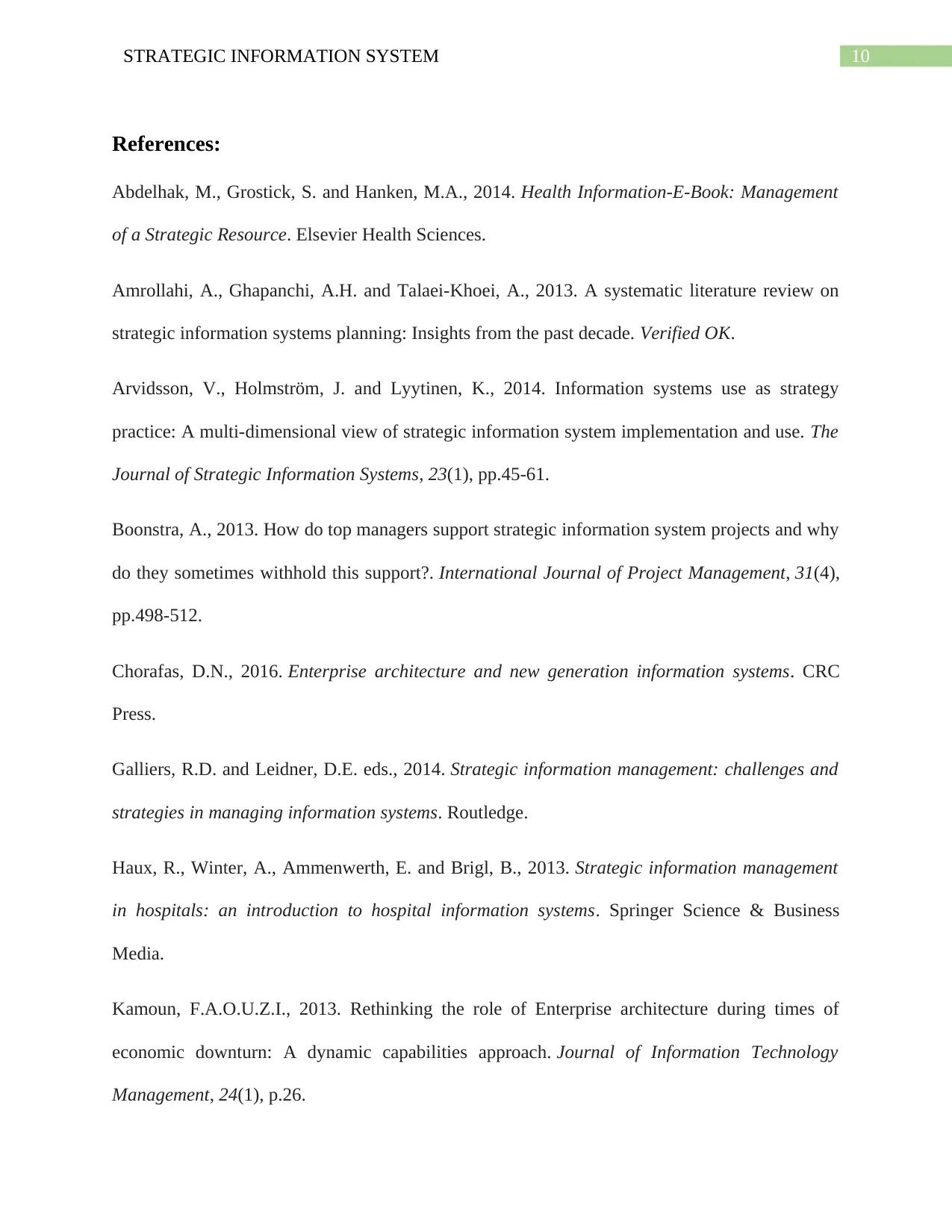
10STRATEGIC INFORMATION SYSTEM
References:
Abdelhak, M., Grostick, S. and Hanken, M.A., 2014. Health Information-E-Book: Management
of a Strategic Resource. Elsevier Health Sciences.
Amrollahi, A., Ghapanchi, A.H. and Talaei-Khoei, A., 2013. A systematic literature review on
strategic information systems planning: Insights from the past decade. Verified OK.
Arvidsson, V., Holmström, J. and Lyytinen, K., 2014. Information systems use as strategy
practice: A multi-dimensional view of strategic information system implementation and use. The
Journal of Strategic Information Systems, 23(1), pp.45-61.
Boonstra, A., 2013. How do top managers support strategic information system projects and why
do they sometimes withhold this support?. International Journal of Project Management, 31(4),
pp.498-512.
Chorafas, D.N., 2016. Enterprise architecture and new generation information systems. CRC
Press.
Galliers, R.D. and Leidner, D.E. eds., 2014. Strategic information management: challenges and
strategies in managing information systems. Routledge.
Haux, R., Winter, A., Ammenwerth, E. and Brigl, B., 2013. Strategic information management
in hospitals: an introduction to hospital information systems. Springer Science & Business
Media.
Kamoun, F.A.O.U.Z.I., 2013. Rethinking the role of Enterprise architecture during times of
economic downturn: A dynamic capabilities approach. Journal of Information Technology
Management, 24(1), p.26.
References:
Abdelhak, M., Grostick, S. and Hanken, M.A., 2014. Health Information-E-Book: Management
of a Strategic Resource. Elsevier Health Sciences.
Amrollahi, A., Ghapanchi, A.H. and Talaei-Khoei, A., 2013. A systematic literature review on
strategic information systems planning: Insights from the past decade. Verified OK.
Arvidsson, V., Holmström, J. and Lyytinen, K., 2014. Information systems use as strategy
practice: A multi-dimensional view of strategic information system implementation and use. The
Journal of Strategic Information Systems, 23(1), pp.45-61.
Boonstra, A., 2013. How do top managers support strategic information system projects and why
do they sometimes withhold this support?. International Journal of Project Management, 31(4),
pp.498-512.
Chorafas, D.N., 2016. Enterprise architecture and new generation information systems. CRC
Press.
Galliers, R.D. and Leidner, D.E. eds., 2014. Strategic information management: challenges and
strategies in managing information systems. Routledge.
Haux, R., Winter, A., Ammenwerth, E. and Brigl, B., 2013. Strategic information management
in hospitals: an introduction to hospital information systems. Springer Science & Business
Media.
Kamoun, F.A.O.U.Z.I., 2013. Rethinking the role of Enterprise architecture during times of
economic downturn: A dynamic capabilities approach. Journal of Information Technology
Management, 24(1), p.26.
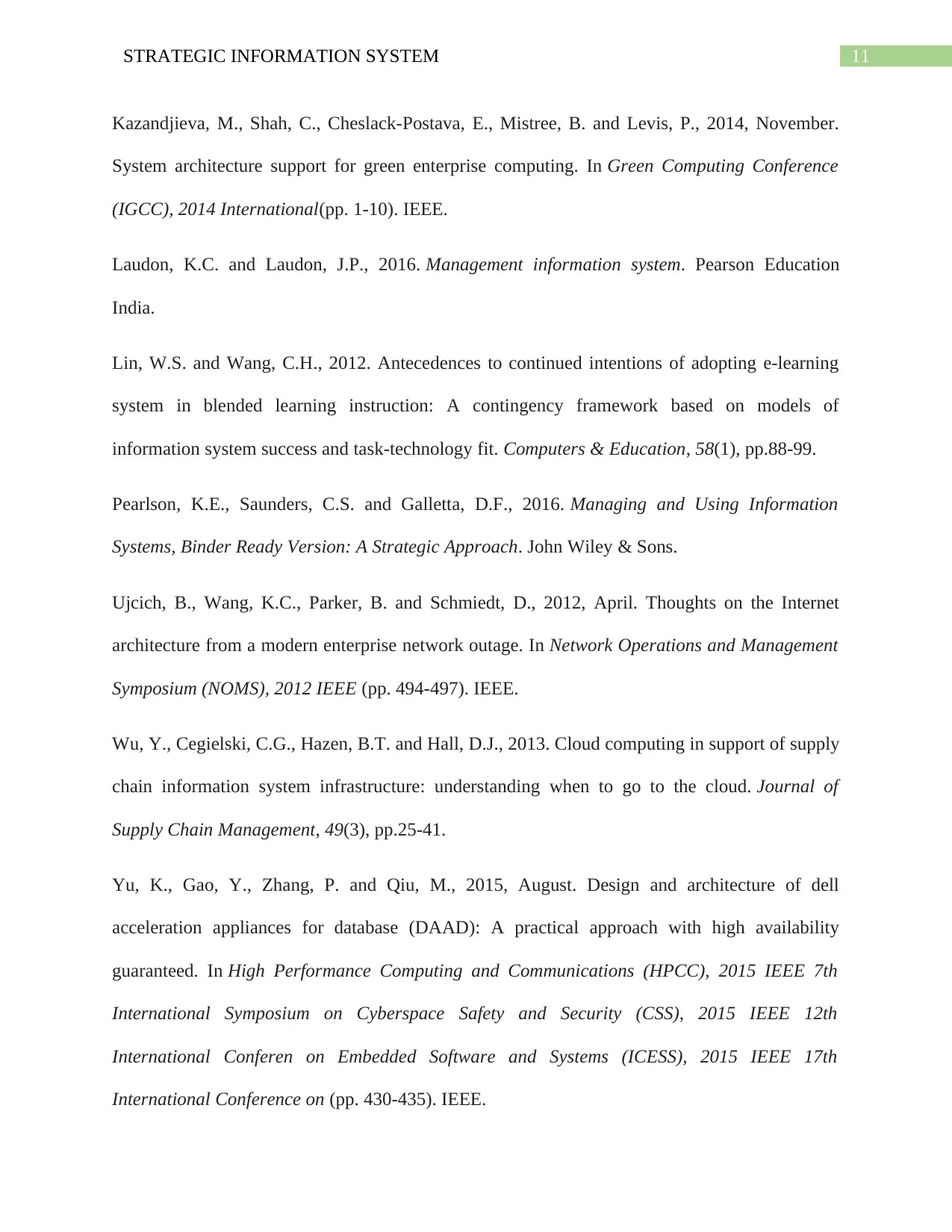
11STRATEGIC INFORMATION SYSTEM
Kazandjieva, M., Shah, C., Cheslack-Postava, E., Mistree, B. and Levis, P., 2014, November.
System architecture support for green enterprise computing. In Green Computing Conference
(IGCC), 2014 International(pp. 1-10). IEEE.
Laudon, K.C. and Laudon, J.P., 2016. Management information system. Pearson Education
India.
Lin, W.S. and Wang, C.H., 2012. Antecedences to continued intentions of adopting e-learning
system in blended learning instruction: A contingency framework based on models of
information system success and task-technology fit. Computers & Education, 58(1), pp.88-99.
Pearlson, K.E., Saunders, C.S. and Galletta, D.F., 2016. Managing and Using Information
Systems, Binder Ready Version: A Strategic Approach. John Wiley & Sons.
Ujcich, B., Wang, K.C., Parker, B. and Schmiedt, D., 2012, April. Thoughts on the Internet
architecture from a modern enterprise network outage. In Network Operations and Management
Symposium (NOMS), 2012 IEEE (pp. 494-497). IEEE.
Wu, Y., Cegielski, C.G., Hazen, B.T. and Hall, D.J., 2013. Cloud computing in support of supply
chain information system infrastructure: understanding when to go to the cloud. Journal of
Supply Chain Management, 49(3), pp.25-41.
Yu, K., Gao, Y., Zhang, P. and Qiu, M., 2015, August. Design and architecture of dell
acceleration appliances for database (DAAD): A practical approach with high availability
guaranteed. In High Performance Computing and Communications (HPCC), 2015 IEEE 7th
International Symposium on Cyberspace Safety and Security (CSS), 2015 IEEE 12th
International Conferen on Embedded Software and Systems (ICESS), 2015 IEEE 17th
International Conference on (pp. 430-435). IEEE.
Kazandjieva, M., Shah, C., Cheslack-Postava, E., Mistree, B. and Levis, P., 2014, November.
System architecture support for green enterprise computing. In Green Computing Conference
(IGCC), 2014 International(pp. 1-10). IEEE.
Laudon, K.C. and Laudon, J.P., 2016. Management information system. Pearson Education
India.
Lin, W.S. and Wang, C.H., 2012. Antecedences to continued intentions of adopting e-learning
system in blended learning instruction: A contingency framework based on models of
information system success and task-technology fit. Computers & Education, 58(1), pp.88-99.
Pearlson, K.E., Saunders, C.S. and Galletta, D.F., 2016. Managing and Using Information
Systems, Binder Ready Version: A Strategic Approach. John Wiley & Sons.
Ujcich, B., Wang, K.C., Parker, B. and Schmiedt, D., 2012, April. Thoughts on the Internet
architecture from a modern enterprise network outage. In Network Operations and Management
Symposium (NOMS), 2012 IEEE (pp. 494-497). IEEE.
Wu, Y., Cegielski, C.G., Hazen, B.T. and Hall, D.J., 2013. Cloud computing in support of supply
chain information system infrastructure: understanding when to go to the cloud. Journal of
Supply Chain Management, 49(3), pp.25-41.
Yu, K., Gao, Y., Zhang, P. and Qiu, M., 2015, August. Design and architecture of dell
acceleration appliances for database (DAAD): A practical approach with high availability
guaranteed. In High Performance Computing and Communications (HPCC), 2015 IEEE 7th
International Symposium on Cyberspace Safety and Security (CSS), 2015 IEEE 12th
International Conferen on Embedded Software and Systems (ICESS), 2015 IEEE 17th
International Conference on (pp. 430-435). IEEE.
⊘ This is a preview!⊘
Do you want full access?
Subscribe today to unlock all pages.

Trusted by 1+ million students worldwide
1 out of 13
Related Documents
Your All-in-One AI-Powered Toolkit for Academic Success.
+13062052269
info@desklib.com
Available 24*7 on WhatsApp / Email
![[object Object]](/_next/static/media/star-bottom.7253800d.svg)
Unlock your academic potential
Copyright © 2020–2025 A2Z Services. All Rights Reserved. Developed and managed by ZUCOL.





